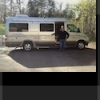
Inside the RV, there’s the faint but sweet smell of the antifreeze I ran through the plumbing last week. The doors to the refrigerator and the freezer are open to air out. The food and coffee in the storage cupboards are emptied. Only a Roadtreking sweatshirt and a Family Motorcoach Association nylon jacket hang in the once crowded wardrobe.
My wide brimmed hat with the pins and buttons collected from national parks and scenic attractions hangs by its neckstring behind the driver’s seat, waiting, seemingly, to be put on and to begin another trip.
You can see your breath when you step inside.
Tai, our 10-year-old Norwegian Elkhound who has had the best year of his life seeing the country in the Roadtrek, guards and patrols it like a treasure. Sometimes he lies down on the driveway, right outside the sliding door. If it’s going anyplace, he seems to be saying, it’s taking him.
The Roadtrek eTrek that has carried us across 33,000 miles of North America over the last 12 months is ready for the cold Michigan winter.
It would shiver if it could.
Inside our sticks and bricks house is a calendar now filled with planned trips for the coming year. But first comes the slowest travel time of the year, the weeks leading up to Thanksgiving and then Christmas.
So right now, it sits parked and – am I imagining this?- looking lonesome and forlorn.
Do RVs dream?
Silly question, I know. But we do imbue them with personalities, naming them, referring to them by gender specific pronouns. We look at them and think of the places we’ve been, the places we will visit. They represent freedom, adventure, the excitement of pulling out and the call of the open road.
They sure make us dream, don’t they?
Soon, loyal eTrek ... soon.
- Read more...
- 0 comments
- 1194 views

